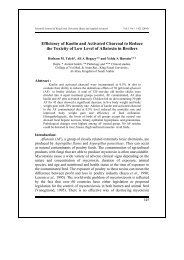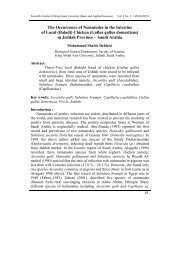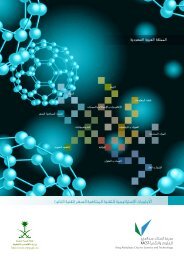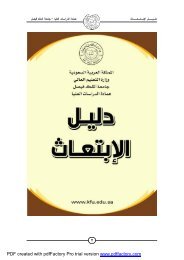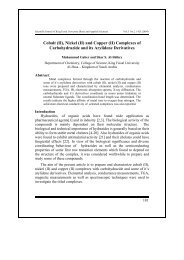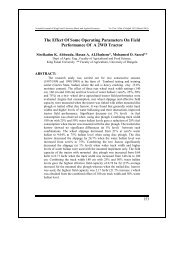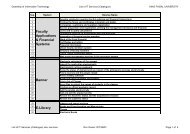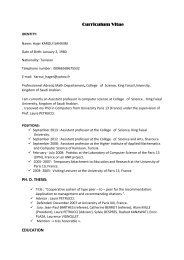Gifted Child Quarterly
Gifted Child Quarterly
Gifted Child Quarterly
Create successful ePaper yourself
Turn your PDF publications into a flip-book with our unique Google optimized e-Paper software.
Garces-Bacsal 145were also indications of grandparents who simply doted ontheir grandchildren (as was evident in the private school narratives)as opposed to tales where the family has difficultymaking ends meet (as was shown in the public school stories).There were also citations of aunts and uncles who providedfinancial support for their nieces and nephews (2 in all, comingfrom the public school setting).The very strong sense of family obligation, typical of mostFilipino households, was observed with narratives containing15 citations of children working to help their families financially(14 coming from the public school group). Four-year-oldJaycee from a public school talked about a child protagonistin Card 9 who decided to sell his toys in order to help hisfamily financially. Five-year-old Jayjay told a story about aboy who performed some errands in another house to earn extramoney to give to his parents.Perception on School and IntelligenceThe children’s perception on school and their motivations forstudying hard varied depending on whether they come froma private school setting or a public school setting. In the former,doing their homework seemed to be matter-of-fact and natural.School work appeared to be part of their routine, or simplywhat was expected of them as students. There were no characterswho actively asked them to do their school work;rather, they do it of their own volition. An illustration wouldbe Pink Princess’ story in the Blank Card (13) (story wasrelated in English and copied verbatim):There are four people there because there are two sons,and then there’s a mommy and a daddy. They’re doingtheir chores in the house, because they’re done with theirhomework, the kids are done with their homework(Q: how are they feeling?) they’re very happy. And thenthey rest. Then the kids watch a little TV, then they rest also.For the public school group, the motivation to study was moregoal-directed. The primary objective was to help their familiesin the future either by getting into a good college or transferringto a better school. The pragmatic view of education as a meansto an end—as a means for survival and to make the family’sfinancial state a little better—was keenly evident in thepublic school children’s narratives. For the private schoolgroup, the primary objective was the love for learning.Although there were also goal-directed intentions, it was notso much the responsibility of providing a better future forthe entire family but rather to help society in general or toenrich one’s being in particular. Themes related to schooland intelligence are listed in Table 4.Predominant Characterization of HeroesThere were 117 citations of heroes who were dominant or activelycontrolled their environment through their determinationTable 4. Comparison of Narrative Themes Related to School andIntelligenceThemes Related toTotal No. ofSchool and Intelligence Private Public CitationsImportance of studying hard 7 9 16Education as the key to a better life 0 6 6or desire (65 of these citations came from the private schoolsetting; Table 5).However there were almost an equal number of citationsreferring to submission to natural forces. This may be attributedto the bahala na mentality of most Filipinos, which isloosely translated as fatalism in English. However, as Salazar(1982) pointed out, bahala na does not mean giving up orabsolving one’s self of responsibility through an overrelianceon mysticism. Rather, the person assumes responsibilityfor what is happening and leaves the rest to chance or God.Difference Between Private and Public School HeroesThere were also several dimensions wherein the portrayal ofthe heroes between the public and private school groupsdiverged as seen in the following subthemes.On sensuous impressions. Among the private schoolchildren, their narratives highlighted details about theirsurroundings, the scenery (19 citations), the weather (24),and the comfort afforded by objects (such as their loungingin their own beds or embracing their pillows, 12 citations).The heroes also seemed to take great delight in just takingtime out to smell the flowers, play in the fields, run in thegrass, and bask in the sun—something that was clearlylacking in the public school narratives. An illustration ofsuch a narrative could be found in parts of Ysabella’s storyin Card 13, the blank card (quoted verbatim):So the picture is, there’s a sun here, this is sort of like apoem. The sky is blue, then there’s grass all around withsunflowers all popping out. The poem is . . . the sun isshining warm and bright. It’s so warm it makes me feelas if everything is all right. With the birds chirping andthe wind blowing gently, blowing my hair here and there.The water in the pond is as blue as the sky. The fishes arejumping all around in a circle. The children are playingon the edge of the lake. And since it’s summer they liketo play there all day. The flowers would bloom allaround. There are sunflowers everywhere you look.Their long pretty petals shining like the sun. At night, inthe evening, there’s a cool breeze with the full moonshining down on . . . the moon makes my face look palein the dark, and I see my reflection on the lake.Most of the other narratives indicated a quiet joy in solitude,happiness in relishing one’s meal, or simply gazing out intoDownloaded from http://gcq.sagepub.com at Brunel University on June 9, 2010



